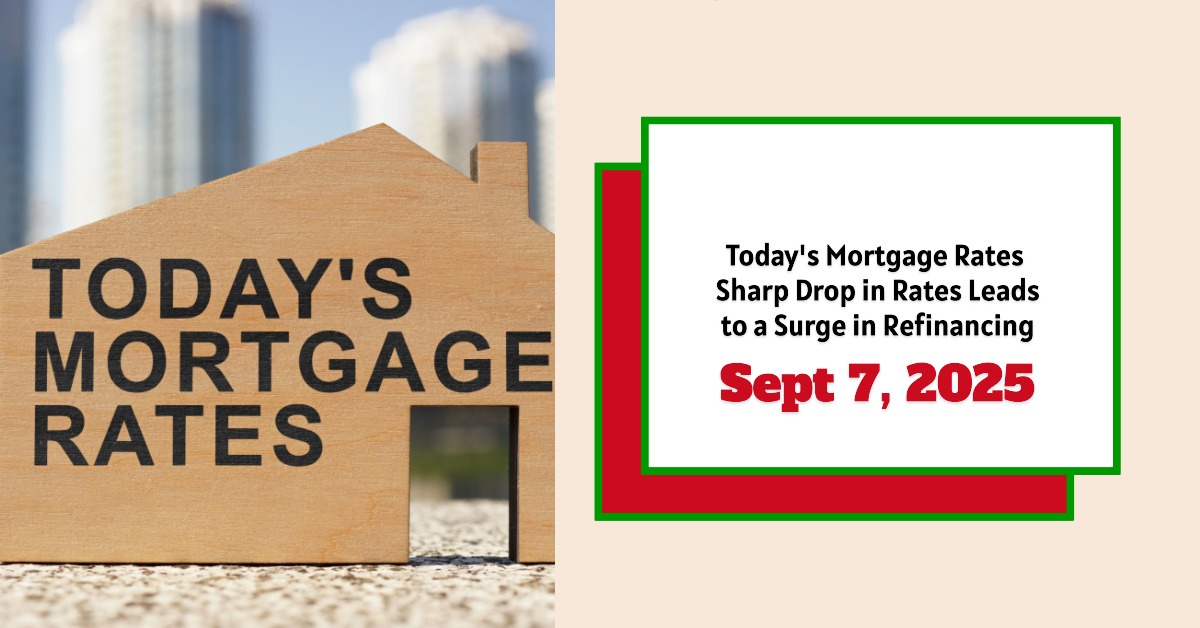Today, on September 7, 2025, mortgage rates have notably dropped, with the average 30-year fixed mortgage rate decreasing to 6.40%, down 19 basis points from last week’s 6.59%, according to Zillow’s latest data. This decline continues a trend of falling rates, which is good news for both homebuyers and those looking to refinance.
Refinance rates have also plunged, with 30-year fixed refinance rates falling to 6.60%, down 24 basis points from last week. According to Freddie Mac, the share of market mortgage applications that were for a refinance reached nearly 47%, the highest since October. The overall trend signals improving affordability and increased opportunities for homeowners and buyers to lock in better mortgage terms.
Today's Mortgage Rates – September 7, 2025: Sharp Drop in Rates Leads to a Surge in Refinancing
Key Takeaways
- 30-year fixed mortgage rate falls to 6.40%, down from 6.59% last week, per Zillow.
- Refinance rates also decline, with the 30-year fixed hitting 6.60%.
- Labor market weakness with slowed job growth is pushing expectations of Federal Reserve rate cuts, potentially driving mortgage rates lower.
- Buy and refinance activities are increasing nationwide as mortgage rates ease across loan types.
- Experts forecast rates will hover above 6% through 2025 but may decline toward 6.1% by 2026.
- Different loan programs (FHA, VA, ARM, Fixed) show varied rate movements, but most are declining.
- The Federal Reserve is anticipated to cut interest rates in mid-September, which could further lower mortgage rates.
Current Overview of Mortgage Rates Today – September 7, 2025
Across the United States, conforming loan rates are trending downwards. The major changes in rates this week reflect optimism as interest rates ease:
| Loan Type | Current Rate | 1-Week Change | APR | 1-Week Change |
|---|---|---|---|---|
| 30-Year Fixed | 6.40% | -0.18% | 6.84% | -0.19% |
| 20-Year Fixed | 5.90% | -0.54% | 6.34% | -0.50% |
| 15-Year Fixed | 5.43% | -0.22% | 5.71% | -0.23% |
| 10-Year Fixed | 5.79% | 0.00% | 6.09% | 0.00% |
| 7-Year ARM | 6.83% | -0.21% | 7.70% | 0.00% |
| 5-Year ARM | 6.68% | -0.20% | 7.51% | -0.08% |
(Source: Zillow – Mortgage Rates Today)
Government-backed loans also saw some movement:
| Loan Type | Current Rate | 1-Week Change | APR | 1-Week Change |
|---|---|---|---|---|
| 30-Year FHA | 6.44% | +0.42% | 7.45% | +0.42% |
| 30-Year VA | 5.85% | -0.21% | 6.07% | -0.20% |
| 15-Year FHA | 5.13% | -0.38% | 6.09% | -0.38% |
| 15-Year VA | 5.53% | -0.17% | 5.88% | -0.14% |
Interestingly, while FHA 30-year rates rose slightly, VA loans and most other government loans declined, showing a mixed but generally favorable environment for borrowers using government-backed programs.
Refinance Rates Also Plunge
The refinance market has experienced a similar trend with rates dropping across the board, improving affordability for homeowners seeking to lower monthly payments or tap into home equity:
| Refinance Loan Type | Current Rate | 1-Week Change |
|---|---|---|
| 30-Year Fixed | 6.60% | -0.07% |
| 15-Year Fixed | 5.38% | -0.01% |
| 5-Year ARM | 7.05% | -0.05% |
(Source: Zillow – Refinance Rates Today)
To put this in perspective, a homeowner refinancing a $300,000 loan at 6.60% vs. 6.84% could save over $50 monthly in interest alone over a 30-year amortization, which adds up considerably over time.
Economic Drivers Behind Mortgage Rate Changes
Mortgage rates are very sensitive to economic conditions, especially the moves by the Federal Reserve. Here’s how recent economic developments connect with today’s mortgage rate drops:
- The August 2025 jobs report showed only 22,000 jobs added and an increase in the unemployment rate to 4.3%, signaling a cooling labor market. This weak job growth suggests slower economic momentum.
- Inflation remains somewhat persistent but is showing signs of cooling, with Core PCE inflation around 2.7%.
- These factors have increased market expectations that the Federal Reserve will cut interest rates by at least 0.25% at their September 16–17 meeting—some call for an even larger 0.5% cut.
- Bond yields, particularly the 10-year Treasury yield, have fallen, reflecting investor anticipation of easier monetary policy. Since mortgage rates typically track 10-year Treasury yields, this drives mortgage rates down.
- The anticipated Fed policy shift was further supported by a close split in the Federal Reserve Board decision on July 30, 2025, where a minority favored immediate rate cuts.
From 2021 to 2023, aggressive Fed rate hikes pushed mortgage rates to 20-year highs. But now, in 2025, the Fed’s pivot to cuts and labor market softness creates conditions ripe for lower mortgage rates, fueling refinance and homebuying momentum.
Market Forecast: What Comes Next for Mortgage Rates?
Experts and organizations offer these projections:
| Source | End-2025 Forecast | 2026 Forecast | Notes |
|---|---|---|---|
| National Association of REALTORS® | 6.4% | 6.1% | Rates as “magic bullet” for buyer affordability |
| Fannie Mae | 6.5% | 6.1% | Mortgage originations rising moderately |
| Realtor.com | 6.4% (year-end) | N/A | Rates ease slowly, matching prior year levels |
| Mortgage Bankers Association | 6.7% | 6.5% | Rates remain volatile through 2025-26 |
These forecasts indicate that mortgage rates are expected to remain above 6% through the end of 2025 but start easing toward historic norms (around 6.1%) in 2026. However, the exact pace depends heavily on economic data and Fed decisions.
How This Influences Buyers and Homeowners
- For potential homebuyers, the decline in mortgage rates over the past weeks may provide an opening that was not available during the earlier, higher-rate months of 2025. Even small declines in interest rates can translate into substantial monthly savings and improve affordability, encouraging buyers to enter the market.
- For current homeowners, falling mortgage refinance rates mean more have opportunities to lower monthly payments or shorten loan terms through refinancing. The increased refinance share (nearly 47% of mortgage applications per Freddie Mac, the highest since the prior October) indicates many are seizing this chance.
- Real estate investors and market watchers pay close attention to these rate moves, as they affect housing demand, pricing trends, and overall market activity.
Example Mortgage Payment Comparison
To visualize the impact of today’s rate change, consider a $350,000 loan amount on a 30-year fixed mortgage:
| Interest Rate | Monthly Principal & Interest Payment | Total Interest Over 30 Years |
|---|---|---|
| 6.59% (Last Week) | $2,230 | $436,800 |
| 6.40% (Today) | $2,180 | $430,800 |
This 0.19% drop in rate reduces the monthly payment by about $50 and saves nearly $6,000 in interest over the life of the loan.
What Sets Today’s Mortgage Rate Environment Apart?
- The surge in refinance applications and buyer interest stems from a rare alignment where weakening job growth meets declining inflation signals. Normally, lower unemployment supports higher rates, but the current slowdown means the Fed may prioritize stimulating growth.
- The anticipated Federal Reserve rate cut is a pivotal event, expected to happen mid-September 2025. This creates a unique window where both borrowing and refinancing become more attractive.
- Market volatility remains, especially for adjustable-rate mortgages (ARMs), which have seen small but significant shifts. Borrowers choosing ARMs must be aware these rates can fluctuate based on short-term trends.
- Despite some fluctuations in FHA rates, conventional mortgage rates continue to trend steadily downward, suggesting lenders see less risk in these loan categories.
Related Topics:
Mortgage Rates Trends as of September 6, 2025
Mortgage Rates Predictions Next 90 Days: August to October 2025
The Federal Reserve’s Role in Mortgage Rates: Detailed Look
Mortgage rates usually mirror the bond market, especially the 10-year Treasury note yields, which reflect investor sentiment about inflation and Fed policy. The Fed’s recent decisions and impending interest rate cut will directly influence these yields and thus mortgage rates.
- The Fed’s previous aggressive hikes lifted mortgage rates sharply between 2022–2023.
- After a steady period in early 2025 with no rate changes, the Fed’s September move is expected to reduce the federal funds rate.
- This rollback is likely to continue into late 2025 and 2026, pushing bond yields and mortgage rates lower.
- Investors closely monitor labor market data, inflation reports, and Fed statements for clues on future monetary actions.
Mortgage rates on this September 7, 2025, offer a welcome break compared to earlier in the year, especially for those seeking long-term home financing or refinancing. The broad drop across fixed and adjustable mortgage types, and across conventional and government-backed loans, is an encouraging sign of easing borrowing costs for millions of Americans.
Capitalize Amid Rising Mortgage Rates
With mortgage rates expected to remain high in 2025, it’s more important than ever to focus on strategic real estate investments that offer stability and passive income.
Norada delivers turnkey rental properties in resilient markets—helping you build steady cash flow and protect your wealth from borrowing cost volatility.
HOT NEW LISTINGS JUST ADDED!
Speak with a seasoned Norada investment counselor today (No Obligation):
(800) 611‑3060
Also Read:
- Will Mortgage Rates Go Down in 2025: Morgan Stanley's Forecast
- Mortgage Rate Predictions 2025 from 4 Leading Housing Experts
- Mortgage Rate Predictions for the Next 3 Years: 2026, 2027, 2028
- 30-Year Fixed Mortgage Rate Forecast for the Next 5 Years
- 15-Year Fixed Mortgage Rate Predictions for Next 5 Years: 2025-2029
- Will Mortgage Rates Ever Be 3% Again in the Future?
- Mortgage Rates Predictions for Next 2 Years
- Mortgage Rate Predictions for Next 5 Years
- Mortgage Rate Predictions: Why 2% and 3% Rates are Out of Reach
- How Lower Mortgage Rates Can Save You Thousands?
- How to Get a Low Mortgage Interest Rate?
- Will Mortgage Rates Ever Be 4% Again?



